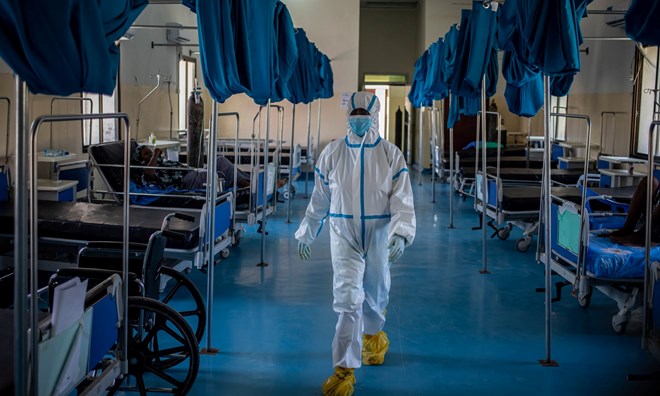
Tuesday September 1, 2020
By Fardosa Hussein, as told to Kaamil Ahmed

A healthcare worker in De Martini hospital in Mogadishu. Photograph: Fardosa Hussein/Arete/DEC
Considering the country was in the middle of a pandemic, the silence at the entrance to Mogadishu’s De Martini hospital felt almost numbing, the expected noise replaced by stillness in its deserted, sanitised halls.
It sent a chill through me as I arrived in May to capture the work being done at what was, until recently, the Somali capital’s only hospital taking coronavirus patients. It felt like a prison.
I was covered from head to toe in PPE kit that made me feel like I was gearing up for the battlefield because I feared contracting the virus myself and what would happen.
Then I stepped inside the treatment centre and found chaos.
There was movement everywhere, a lot of instructions being shouted, a lot of whispering between doctors and nurses. I am used to attracting a lot of attention with my camera but now I felt invisible as the medical staff rushed around me, going from patient to patient or trying to change oxygen tanks. I was just trying to stand to the side and not interfere.
Even before the arrival of Covid-19, Somalia faced what seemed like insurmountable odds: ongoing insecurity, the worst desert locust infestation in decades, flash flooding that has affected more than 1 million people since March, and a cholera outbreak that began in 2017.
Then coronavirus began taking lives, stretching the health system in a country where 20% of the population is internally displaced, with many people spread out over more than 2,000 settlements, often in or next to crowded urban areas.
When the outbreak began in March, Somalia had no ventilators and just two healthcare workers per 100,000 people.
De Martini hospital has 71 beds and is the main quarantine hospital in the city, which has a population of about 2.5 million, as well as a large displaced community living on the outskirts of the capital.
Officially, the country has had just 93 deaths from the virus, but Action Against Hunger believes the true figure is much higher.
“The official number of cases stands at 3,076, but this number simply doesn’t square with what we are seeing or hearing in our communities” says Ahmed Khalif, Action Against Hunger’s country director in Somalia.
“Early evidence suggests the pandemic is slowing other health services, and we are seeing an alarming rise in hunger and malnutrition levels, particularly among the most vulnerable communities. If current trends continue, child mortality could increase an estimated 13% in Somalia. This is not normal. There is obviously a problem.”
When I roamed around Mogadishu three months ago I found so many people were still unsure about what to believe – and often quite sceptical about information they were given. When photographing in markets, I tried to blend in by wearing a niqab to cover my face mask, because a lot of people thought anyone who wore one was exaggerating the threat.
Related: 'They think they’ll be left to die': pandemic shakes already fragile Venezuela
In Mogadishu’s displacement camps, I came across people who believed the virus was a problem that existed in the main city but did not affect them, even though they lived in crowded conditions with limited access to essential healthcare, water and sanitation.
Many people had also started to believe that anyone who entered De Martini hospital never left.
In Somalia, 20% of the population is internally displaced, living in camps such as Kahda (main image) and Xidig.
Action Against Hunger, one of a handful of health charities working to combat the virus, was working with the health ministry to provide medical staff, training and vital PPE to ensure Somalia could respond to the crisis.
But despite the country’s best efforts, its ability to respond to a pandemic remained inadequate. While oxygen tanks were available at the hospital, ventilators to treat the most serious cases of Covid-19 remained scarce. “If a patient needs to be intubated, we will have to watch the patient suffer because we can’t do anything. Eventually they will die,” Dr Xilwo Daud, who supervised the ward, told me at the time.
With 60 cases already confirmed among the staff at De Martini hospital, all staff were housed on the premises to minimise the risk of spreading the virus. Despite missing their loved ones, it was a sacrifice they were taking in their stride.
“I believe the reason I went to school to get an education is that if such pandemics take place, I can be on the frontline to support my people,” said Daud, who was forced to leave her young daughter with her parents.
Children use ash and soil to wash their hands at Xidig IDP camp in Mogadishu.
Somalia is now entering the dry season, and malnutrition levels are expected to rise. According to the UN, one in five people in the country (3.5 million) will be pushed into food insecurity by September, and more than 1 million children will be malnourished. With already limited healthcare facilities struggling because of Covid-19, there are fears that aid agencies will not be able to cope in the face of overwhelming humanitarian need.
Khalif is sombre in his appraisal of Somalia’s prospects. “The situation in Somalia is incredibly grave. Our health system has been overwhelmed and the money is drying up. Without more support from the international community, I fear Covid-19 could be the straw that breaks the camel’s back.”